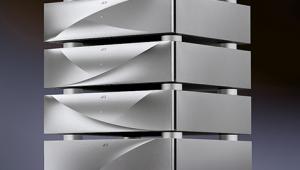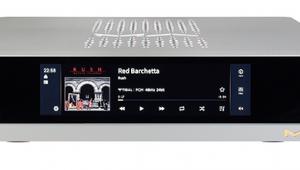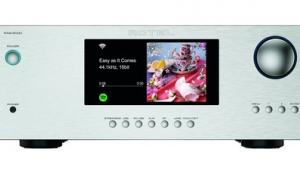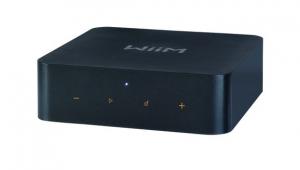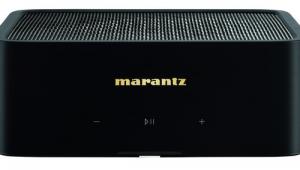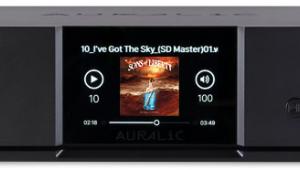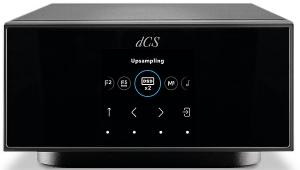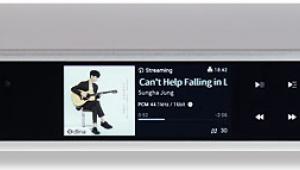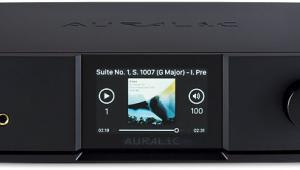Pro Ject Stream Box Ds (£699)
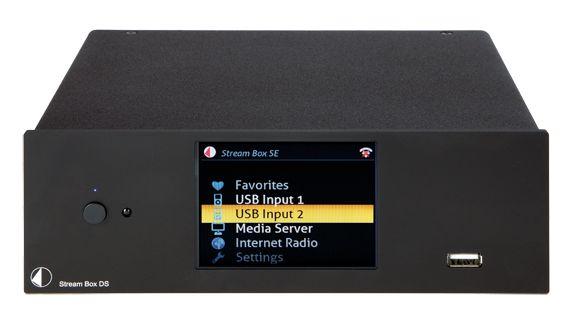
The market for network media streamers has expanded dramatically in the last 12 months and with it the number of units available to choose from. Although the process of buying high quality music via download is still somewhat lacking in choice, the advantages of well implemented network audio are becoming apparent to an ever wider circle of buyers. A happy combination of more effective user interfaces and greater understanding of networks amongst the general public has reduced the complexity of installation.
No longer content with limiting itself to producing a bewildering variety of turntables, a few years ago Pro-Ject moved into amplification and other source equipment. The Box series comprises extremely compact amplifiers, DACs and iPod docks and larger ‘half-width’ units including CD players and monoblock amplifiers. The Stream Box adds high resolution audio streaming to the range, and is built into the larger of these two chassis types.
BOXING CLEVER
Pro-Ject’s expertise has historically been with analogue components, so it’s not too surprising to discover that the Stream Box DS makes use of a third-party solution. The StreamUnlimited interface was first seen in Musical Fidelity’s highly regarded CLiC [HFN June ’11] but while the CLiC combines a StreamUnlimited front end with its own re-clocking and DAC solution, the Stream Box DS looks, on the face of it, like a more straightforward implementation [see www.streamunlimited.com/v3/en/audio_streaming_client.html].
This results in a rather simpler unit than the CLiC. The Stream Box has no digital inputs, no preamp functions and no analogue inputs. Connectivity is limited to two USB sockets, a single pair of phono sockets and a coaxial digital output. The upside to this stripped-back functionality is that the Stream Box is slightly over half the price of the CLiC. One feature that does make the transition to the Pro-Ject is the full colour TFT screen on the front panel which is something not present on similarly priced competitive products. This is both legible at a reasonable distance and is able to display album art.
The Pro-Ject supports the majority of available audio formats and, crucially, supports FLAC and LPCM streaming up to 24-bit/192kHz. This makes it one of the cheapest units to do so and hopefully lends it a degree of future proofing. The Pro-Ject is able to stream via Ethernet or supplied wireless aerial but, given that wireless support does not include 802.11n, anyone looking to stream high resolution material would be better served by using the Ethernet connection. Internet radio services are provided by vTuner and seem relatively comprehensive if not quite as lavish as Naim’s full implementation of the same software.
APPLE FRIENDLY
The front panel USB connection is also capable of music playback from an Apple device up to and including ALAC files. This requires the iPod or iPad to be physically connected to the Stream Box and controlled via the remote, which is less tactile than the iPod itself. AirPlay would have been a nice addition but this implementation is more than acceptable. No dedicated iPhone or iPod control app exists but the Plug Player control app is able to perform the same functions.
Fit and finish is solid if not spectacular. The Stream Box uses the new ‘DS’ version of the Pro-Ject Box casework with no visible screwheads, and this relatively small unit weighs over 2.5 kilos which – given that it contains no power supply – suggests reasonably solid metalwork. The power supply is an external wall wart type which is silent, but doesn’t feel hugely solid connected to the rear panel.
As the Stream Box only has a standby button by way of front panel control, the remote is used for all areas of set-up and playback. The handset itself is a small plastic affair that is a prime candidate to vanish down the side of a sofa but the layout of the buttons is logical and the response of the Stream Box to it is prompt and effective.
Using Twonky media server on a Windows laptop, set-up proved quick and painless. The menu process is logical and easy to follow. Once you have carried out the one-time-only set-up to connect the Pro-Ject to your network, or made the relevant Ethernet connections, the Pro-Ject is ready to go. The Stream Box found content quickly and effectively and would start playback of selected material within a second or two of selecting it. Mixing different audio formats in the same file didn’t cause any problems or interruptions during playback.
SOFTLY SPOKEN
Listening was undertaken with a Naim SuperNait and Neat Momentum speakers. The Stream Box was connected to the network via Ethernet and to the amplifier via the phono outputs. Initially, material chosen was exclusively on FLAC files ripped from CD via dBPoweramp ripper. This allowed for comparison between the original CD and streamed file. A Cambridge Audio 840C was on hand as a similarly priced CD player to compare the original disc.
ZZ Top’s Fandango!, remastered to good effect a few years ago, immediately showed up the curiously low output of the Stream Box. The level is significantly lower than from a standard CD player and requires more wick from the amplifier to validate A/B comparisons. Once levels were raised to compensate, the Stream Box managed to convey the frenetic energy of the performance and enthusiasm of the crowd in the extended live performance of ‘Backdoor Medley’. This is a claustrophobic recording and the Pro-Ject preserved the raw energy of the piece. The overall tonality felt authentically thick and energetic as well.
Switch to the more finessed recording of Strange Times by The Chameleons and the news is less positive. This is a recording with a more potent low end than the ZZ Top piece and it highlights that the Pro-Ject – even after level correction – is somewhat bass light. The bass that is present has reasonable detail and control, but there is a distinct lack of the force and impact to the recording that was present and correct when the CD was used instead. This is a shame because the rest of the piece comes across with all of the ’80s gloss of the production intact.
Upping the ante and moving to a 24-bit/96kHz download of Paul Simon’s So Beautiful Or So What brought an attendant step forward in quality (although the standard CD version is no slouch in this regard) but the sense that the low frequency response had been diluted remained. The Pro-Ject seemed unable to find that last few percent of depth and impact that makes the difference between the recorded and the real. Connecting to the SuperNait or 840C via a digital cable did bring back some weight, and also brought further improvement to the air and space of the presentation over the analogue connection.
INTERNET RADIO
Compressed material shows up much of the same behavioural traits in the Stream Box but also reveals that it is extremely forgiving of poorer recordings and manages to stay listenable with material down to and including 160kbps AAC files. This benign behaviour with lower bitrate material also translates into solid internet radio performance across a wide variety of stations. The station list appears to be usefully up to date and ploughing through the more esoteric ends of the lists revealed very few dead links.
The iPod connection is similar in behaviour to the playback over network. The software directly accesses the music placed on the Apple device via iTunes which precludes playing Spotify or other music-on-demand services via the Stream Box. This minor gripe apart, the Pro-Ject sounded entirely competent with material in bitrates up to and including ALAC material. Au Revoir Simone’s Still Night, Still Light coded in ALAC, played via iPhone sounded very similar to the same album replayed in FLAC over network, with the same pleasant tonality but a lack of low end weight as was found with other pieces. This behaviour continued over the USB connection when the same album was replayed via a memory stick.
The result is a product that is hard to endorse fully. The Stream Box has an interface and display that is well thought out, easy to use and extremely stable. The colour screen is a rare attribute at the price and this gives the Pro-Ject an advantage over many of its key competitors. Build quality (slightly ill-fitting power supply aside) is competitive as well. The lack of low end heft and weight can be partly alleviated by connecting the Stream Box to a well sorted DAC but doing so erodes some of its price advantage.
VERDICT
The Pro-Ject Stream Box has a well thought out feature set and the implementation of the menus and control interface are good. It is also very forgiving of compressed material. The lightweight sound is somewhat disappointing however, and it struggles to take advantage of some of the benefits of well realised network audio with both lossless and high resolution files. It also faces no shortage of competition.
Originally published in the January 2012 issue



